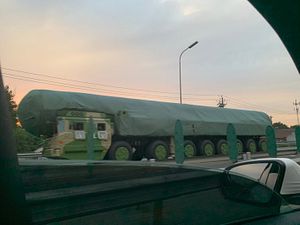China’s Tuesday military parade to commemorate the 70th anniversary of the founding of the People’s Republic in 1949 is a hotly anticipated event. For the community of China military-watchers in particular, the day is expected to coincide with the public reveal of several long-scrutinized — but seldom seen — weapons systems. What follows is a short guide of what to look for as you watch Tuesday’s parade.
On top of most observers’ lists at the upcoming parade is the Dong Feng 41, or DF-41, intercontinental-range ballistic missile. This system is almost an assured appearance at the parade, with its transporter-erector-launcher (TEL) vehicle having been seen at the parade training grounds near Beijing in the late-summer. The DF-41 is assessed by the United States to be a large, solid-fuel-based ICBM, capable of throwing an undisclosed number of multiple independently targetable reentry vehicles (MIRVs) as far as the continental United States.
Another highly anticipated system at the upcoming parade is the Dong Feng 17, or DF-17, a missile system that was first exclusively revealed by The Diplomat in 2017. DF-17 is China’s first hypersonic glide vehicle-toting ballistic missile expected to enter operational service with the People’s Liberation Army Rocket Force (PLARF) as soon as next year. This system has never been seen publicly, but has undergone multiple flight-tests beginning in 2017. Pre-parade imagery from Beijing has revealed a new TEL likely for the DF-17 in the city’s streets, but the exact presence of this system is less of a sure thing compared to the DF-41. The DF-17, however, would make a powerful point on China’s military modernization. No other country currently deploys a nonstrategic hypersonic glide vehicle operationally; Russia has deployed its Avangard hypersonic glider on some ICBMs in very limited numbers.
An unexpected system that has shown up in more recent rumors on parade appearances in the JL-2 submarine-launched ballistic missile, the second-generation SLBM in service with the People’s Liberation Army Navy, currently deployed on its Type 094 ballistic missile submarines. The JL-2 making an appearance would be a reminder of the important role China’s naval nuclear forces are now playing. The JL-2’s successor, the JL-3, began testing last year and is expected to bring a significantly longer-range capability to the table. The JL-2 is slated to make its first parade appearance this year.
As far as nuclear forces are concerned, it’s clear that the parade will shed light on both China’s land- and sea-based capabilities. But what about the Air Force? The U.S. Department of Defense, in its most recent report on Chinese military capabilities, assessed that the People’s Liberation Army Air Force’s newly reassigned nuclear delivery role will be realized in the form of a new air-launched ballistic missile — likely the missile known to the U.S. intelligence community as the CH-AS-X-13. There have been no sightings of this system before the parade, but one astute observer of the Chinese military noticed a newly modified variant of the H-6N, the bomber meant to carry the new ALBM, with a missing bomb bay. Of all the nuclear-capable systems, the new Chinese ALBM is the least likely to make an appearance on Tuesday, however. The PLAAF will have other nonnuclear assets to make its presence and modernization apparent.
For the PLARF, many of the other systems expected to make a parade appearance are at this point old news. These include the DF-31AG, which is an integrated TEL variant of the DF-31 and first made an appearance in 2017. The “Guam-killer” DF-26, a dual-capable conventional and nuclear intermediate-range ballistic missile, will also return. Finally, the DF-5A/B, some of China’s older, but longest-range liquid-propellant ICBMs, will also make a come back. On the nonnuclear front, Beijing is also expected to unveil two new unmanned aerial vehicles, one of which appears to be the stealthy Sharp Sword stealth UAV and the other an unknown supersonic system.
Tuesday’s parade will underscore China’s rapid military modernization in conventional and nuclear capabilities alike. While Beijing’s nuclear policy remains mostly stagnant, its capabilities are rapidly changing in qualitative terms. No doubt, there’ll be many eyes all over the world paying attention to the grand unveiling of many of these systems on October 1.

































